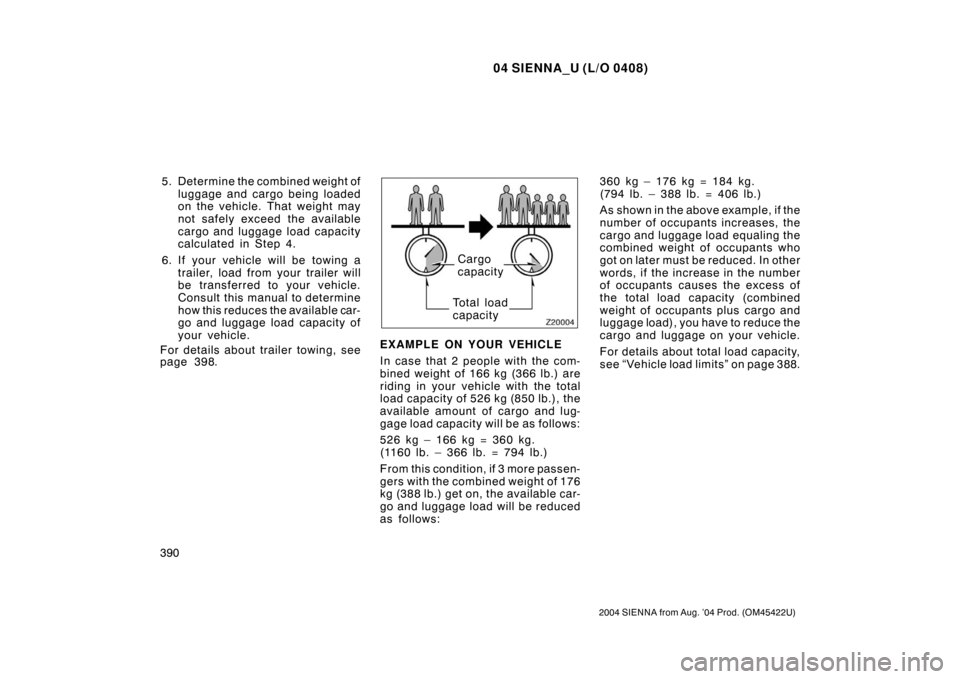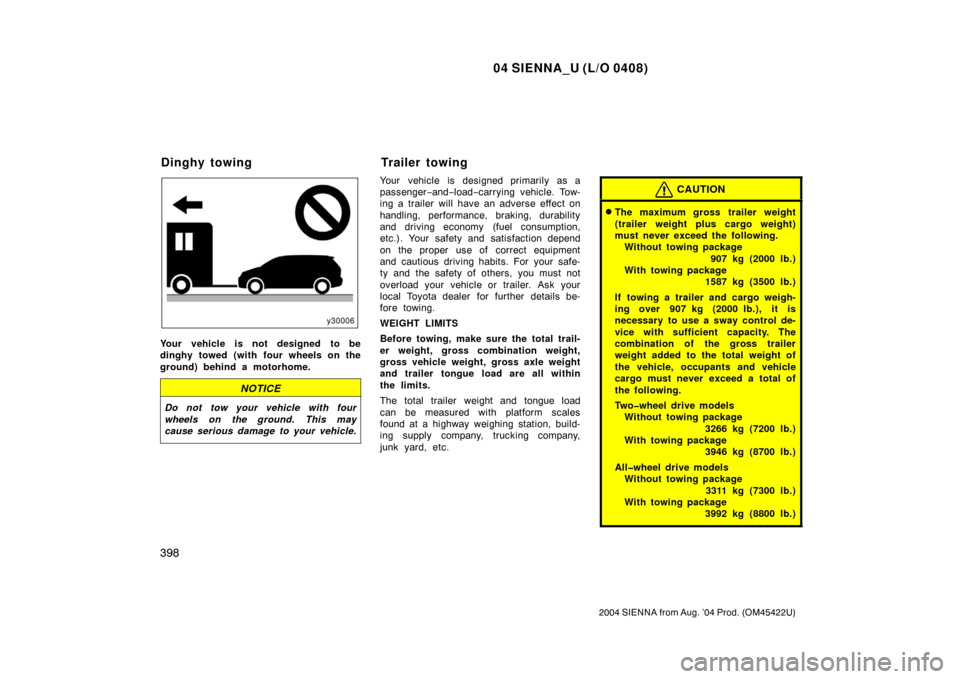Page 394 of 506

04 SIENNA_U (L/O 0408)
388
2004 SIENNA from Aug. ’04 Prod. (OM45422U)
Vehicle load limits include total load
capacity, seating capacity, towing ca-
pacity and cargo capacity. Follow the
load limits shown below.
Total load capacity: 526 kg (1160 Ib.)
Total load capacity means com-
bined weight of occupants, cargo
and luggage. Tongue load is in-
cluded when trailer towing.
Seating capacity: 7−passenger models—
Total 7 (Front 2, Rear 5)
8 −passenger models—
Total 8 (Front 2, Rear 6)
Seating capacity means the maxi-
mum number of occupants whose
estimated average weight is 68 kg
(150 lb.) per person. Depending on
the weight of each person, the seat-
ing capacity given may exceed the
total load capacity. NOTICE
Even if the number of occupants
are within the seating capacity,
do not exceed the total load ca-
pacity.
Towing capacity:
Without towing package 907 kg (2000 Ib.)
With towing package 1587 kg (3500 Ib.)
Towing capacity means the maxi-
mum gross trailer weight (trailer
weight plus its cargo weight) that
your vehicle is able to tow.
Cargo capacity
Cargo capacity may increase or de-
crease depending on the size (weight)
and the number of occupants. For de-
tails, see “Capacity and distribution”
that follows.
CAUTION
Do not apply the load more than
each load limit. That may cause
not only damage to the tires, but
also deterioration to the steering
ability and braking ability, which
may cause an accident.
Veh icle lo ad limit s
Page 395 of 506

04 SIENNA_U (L/O 0408)
389
2004 SIENNA from Aug. ’04 Prod. (OM45422U)
When stowing cargo and luggage in
the vehicle, observe the following:� Put cargo and luggage in the lug-
gage compartment when at all
possible. Be sure all items are se-
cured in place.
� Be careful to keep the vehicle bal-
anced. Locating the weight as far
forward as possible helps maintain
balance.
� For better fuel economy, do not
carry unneeded weight.
CAUTION
�To prevent cargo and l uggage
from sliding forward during
braking, do not stack anything
in the luggage compartment
higher than the seatbacks.
Keep cargo and luggage low,
as close to the floor as pos-
sible.
� Never allow anyone to ride in
the luggage compartment. It is
not designed for passengers.
They should ride in their seats
with their seat belts properly
fastened. Otherwise, they are
much more likely to suffer seri-
ous bodily injury, in the event
of sudden braking or a colli-
sion.
� Do not drive with objects left
on top of the instrument panel.
They may interfere with the
driver’s field of view. Or they
may move during sharp vehicle
acceleration or turning, and im-
pair the driver’s control of the
vehicle. In an accident they
may injure the vehicle occu-
pants.Cargo capacity depends on the to-
tal weight of the occupants.
(Cargo capacity) = (Total load capac-
ity) – (Total weight of occupants)
STEPS FOR DETERMINING
CORRECT LOAD LIMIT
1. Locate the statement “The com- bined weight of occupants and
cargo should never exceed XXX
pounds” on your vehicle’s placard.
2. Determine the combined weight of the driver and passengers that will
be riding in your vehicle.
3. Subtract the combined weight of the driver and passengers from
XXX kilograms or XXX pounds.
4. The resulting figure equals the available amount of cargo and lug-
gage load capacity. For example,
if the “XXX” am ount equals 1400
lbs. and there will be five 150 lb.
passengers in your vehicle, the
amount of available cargo and lug-
gage load capacity is 650 lbs.
(1400–750 (5x150)=650 lbs).
Cargo and luggage—
—Stowage precautions —Capacity and distribution
Page 396 of 506

04 SIENNA_U (L/O 0408)
390
2004 SIENNA from Aug. ’04 Prod. (OM45422U)
5. Determine the combined weight ofluggage and cargo being loaded
on the vehicle. That weight may
not safely exceed the available
cargo and luggage load capacity
calculated in Step 4.
6. If your vehicle will be towing a trailer, load from your trailer will
be transferred to your vehicle.
Consult this manual to determine
how this reduces the available car-
go and luggage load capacity of
your vehicle.
For details about trailer towing, see
page 398.
Cargo
capacity
Total load
capacity
EXAMPLE ON YOUR VEHICLE
In case that 2 people with the com-
bined weight of 166 kg (366 lb.) are
riding in your vehicle with the total
load capacity of 526 kg (850 lb.), the
available amount of cargo and lug-
gage load capacity will be as follows:
526 kg – 166 kg = 360 kg.
( 1160 lb. – 366 lb. = 794 lb. )
From this condition, if 3 more passen-
gers with the combined weight of 176
kg (388 lb.) get on , the av ailable car-
go and luggage load will be reduced
as follows: 360 kg – 176 kg = 184 kg.
( 794 lb. – 388 lb. = 406 lb. )
As shown in the above example, if the
number of occupants increases, the
cargo and luggage load equaling the
combined weight of occupants who
got on later must be reduced. In other
words, if the incr
ease in the number
of occupants causes the excess of
the total load capacity (combined
weight of occupants plus cargo and
luggage load), you have to reduce the
cargo and luggage on your vehicle.
For details about total load capacity,
see “Vehicle load limits” on page 388.
Page 404 of 506

04 SIENNA_U (L/O 0408)
398
2004 SIENNA from Aug. ’04 Prod. (OM45422U)
Your vehicle is not designed to be
dinghy towed (with four wheels on the
ground) behind a motorhome.
NOTICE
Do not tow your vehicle with four
wheels on the ground. This may
cause serious damage to your vehicle.
Your vehicle is designed primarily as a
passenger−and− load− carrying vehicle. Tow-
ing a trailer will have an adverse effect on
handling, performance, braking, durability
and driving economy (fuel consumption,
etc.). Your safety and satisfaction depend
on the proper use of correct equipment
and cautious driving habits. For your safe-
ty and the safety of others, you must not
overload your vehicle or trailer. Ask your
local Toyota dealer for further details be-
fore towing.
WEIGHT LIMITS
Before towing, make sure the total trail-
er weight, gross combination weight,
gross vehicle weight, gross axle weight
and trailer tongue load are all within
the limits.
The total trailer weight and tongue load
can be measured with platform scales
found at a highway weighing station, build-
ing supply company, trucking company,
junk yard, etc.CAUTION
�The maximum gross trailer weight
(trailer weight plus cargo weight)
must never exceed the following. Without towing package
907 kg (2000 lb.)
With towing package 1587 kg (3500 lb.)
If towing a trailer and cargo weigh-
ing over 907 kg (2000 lb.), it is
necessary to use a sway control de-
vice with sufficient capacity. The
combination of the gross trailer
weight added to the total weight of
the vehicle, occupants and vehicle
cargo must never exceed a total of
the following.
Two�wheel drive models Without towing package
3266 kg (7200 lb.)
With towing package 3946 kg (8700 lb.)
All�wheel drive models Without towing package
3311 kg (7300 lb.)
With towing package 3992 kg (8800 lb.)
Dinghy towing Trailer towing
Page 494 of 506
04 SIENNA_U (L/O 0408)
488
2004 SIENNA from Aug. ’04 Prod. (OM45422U)
Model:3MZ −FE
Type: 6 cylinder V type 4 cycle, gasoline
Bore and stroke, mm (in.): 92.0 �83.0 (3.62 �3.27)
Displacement, cm
3 (cu. in.):
3311 (201.9)
Dimensions and weights
Overall width mm (in.)
3030 (119.3)
Overall height
mm (in.)
1700 (66.9)
∗2
1710 (67.3)∗3
Wheelbase mm (in.)
Front tread mm (in.)1665 (65.6)
∗
2
1675 (65.9)∗3
Rear tread mm (in.)
538 (1185)
∗1: Unladen vehicle∗2: With P215/65R16 tires∗3: With P225/60R17 tires
Overall length mm (in.)
Vehicle capacity weight
kg (lb.)
(occupants + luggage) 5080 (200.0)
1965 (77.4)
1750 (68.9)
∗
1
Towing capacity
(trailer weight +
cargo weight) kg (lb.)Vehicle without towing package
Vehicle with towing package 907 (2000)
1587 (3500)
Engine